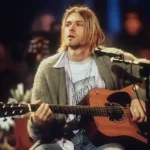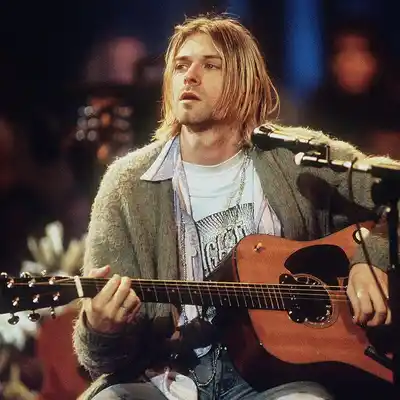
Kurt Cobain – God of Grunge
Kurt Cobain was more than just the frontman of Nirvana, more than just another musician lost tragically young. He was a symbol of a generation’s angst.
His guitar playing, though not technically intricate like some rock gods, was filled with raw emotion.
Table of Contents
Early Days
Born in 1967 in the logging town of Aberdeen, Washington, Kurt’s early life wasn’t a cakewalk. With his parents’ divorce affecting him deeply, he found relief in art and, eventually, music.
Cobain got his first guitar as a teenager and soon began to cover songs by bands like The Beatles and Led Zeppelin.
Nirvana: The Grunge Revolution
In 1987, along with bassist Krist Novoselic, Nirvana was born. After cycling through a slew of drummers, the band solidified its most famous lineup with the addition of Dave Grohl in 1990.
Though they didn’t invent grunge, Nirvana came to define the genre. Melding punk’s raw energy with catchy melodies, they struck a chord with the youth.
When ‘Smells Like Teen Spirit,’ (a track from their second album, “Nevermind,”) hit the airwaves in 1991, it was like a bomb. It became an anthem.
Grunge, for Kurt and for many, was never merely a genre – it was an expression, a way to lace pain with melody. Cobain became one of the pioneers who pushed grunge into the mainstream. But it was never about popularity for him. Music was a deeply personal expression for Cobain.
As “Nevermind” soared to the top of the charts, so did Nirvana’s fame. But Cobain struggled with this newfound attention. He was often outspoken about his discomfort with the media and being thrust into the “rockstar” limelight.
One of Cobain’s most poignant performances was MTV’s Unplugged session in 1993, where he stripped down Nirvana’s hits and covered his favorite artists.
The Icon
Kurt Cobain, despite all his resistance, became an icon. His image – the disheveled hair, piercing blue eyes, and the often-detached conduct – became synonymous with the raw spirit of rock and roll. And even more, he became the unintentional poster boy for a lost, angry, and disillusioned generation.
Cobain’s own relationship with his icon status was tenuous at best. He was often dismissive of the media’s portrayal of him and resisted the “rock star” image that was often thrust upon him.
One could say that it was this resistance, this disregard for norms and expectations that magnetically attracted fans to him.
Style
While often recognized for his lyrical prowess, Cobain’s skill as a guitarist sometimes goes underappreciated. His mastery lay not in complexity but in authenticity. He created sounds that were both haunting and deeply intimate.
So, while Cobain might not make the list of fastest or most intricate guitar players, his unique playing style was iconic in its own right. He had an ability to craft simple yet evocative riffs. For him, it was always about the emotion.
Challenges and Struggles
With fame came personal and health struggles. Cobain battled with substance abuse and the pressures of being viewed as the “voice of a generation.”
Cobain’s own struggles with his mental health, relationships, and addiction were often laid bare in his music.
The Legacy
In 1994, the world was shocked by the news of Cobain’s death.
Kurt Cobain may have left the world tragically and prematurely, but his presence is very much alive.
While his life was filled with complexities and challenges, Cobain’s impact on music and culture is undeniable. His influence can be felt far and wide: from modern rock bands to pop artists.
Nirvana’s induction into the Rock and Roll Hall of Fame in 2014 was a testament to the lasting impact Cobain has had on the music world.
